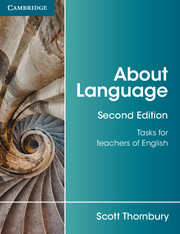Book contents
- Frontmatter
- Contents
- Thanks and Acknowledgements
- Introduction
- Tasks
- Introductory unit
- 1 Language standards and rules
- 2 Varieties of English
- 3 Types of grammar
- 4 Language systems and syllabuses
- 5 Forms and functions
- 6 An introduction to phonology
- 7 The consonants
- 8 The vowels
- 9 Rhythm and connected speech
- 10 Sentence stress and intonation
- 11 Word formation, spelling and word stress
- 12 Lexical meaning
- 13 Word classes and phrases
- 14 Sentence structure: the simple sentence
- 15 Sentence structure: the complex sentence
- 16 Negatives and questions
- 17 The verb phrase
- 18 Time and tense
- 19 Aspect: progressive
- 20 Aspect: perfect
- 21 Modality
- 22 Futurity
- 23 Hypothetical meaning and conditionals
- 24 The noun phrase
- 25 Determiners
- 26 Adjectives and adverbs
- 27 Prepositions and phrasal verbs
- 28 Cohesion
- 29 Texts
- 30 Conversation
- Key and commentaries
- Introductory unit
- 1 Language standards and rules
- 2 Varieties of English
- 3 Types of grammar
- 4 Language systems and syllabuses
- 5 Forms and functions
- 6 An introduction to phonology
- 7 The consonants
- 8 The vowels
- 9 Rhythm and connected speech
- 10 Sentence stress and intonation
- 11 Word formation, spelling and word stress
- 12 Lexical meaning
- 13 Word classes and phrases
- 14 Sentence structure: the simple sentence
- 15 Sentence structure: the complex sentence
- 16 Negatives and questions
- 17 The verb phrase
- 18 Time and tense
- 19 Aspect: progressive
- 20 Aspect: perfect
- 21 Modality
- 22 Futurity
- 23 Hypothetical meaning and conditionals
- 24 The noun phrase
- 25 Determiners
- 26 Adjectives and adverbs
- 27 Prepositions and phrasal verbs
- 28 Cohesion
- 29 Texts
- 30 Conversation
- References
- Index
- Frontmatter
- Contents
- Thanks and Acknowledgements
- Introduction
- Tasks
- Introductory unit
- 1 Language standards and rules
- 2 Varieties of English
- 3 Types of grammar
- 4 Language systems and syllabuses
- 5 Forms and functions
- 6 An introduction to phonology
- 7 The consonants
- 8 The vowels
- 9 Rhythm and connected speech
- 10 Sentence stress and intonation
- 11 Word formation, spelling and word stress
- 12 Lexical meaning
- 13 Word classes and phrases
- 14 Sentence structure: the simple sentence
- 15 Sentence structure: the complex sentence
- 16 Negatives and questions
- 17 The verb phrase
- 18 Time and tense
- 19 Aspect: progressive
- 20 Aspect: perfect
- 21 Modality
- 22 Futurity
- 23 Hypothetical meaning and conditionals
- 24 The noun phrase
- 25 Determiners
- 26 Adjectives and adverbs
- 27 Prepositions and phrasal verbs
- 28 Cohesion
- 29 Texts
- 30 Conversation
- Key and commentaries
- Introductory unit
- 1 Language standards and rules
- 2 Varieties of English
- 3 Types of grammar
- 4 Language systems and syllabuses
- 5 Forms and functions
- 6 An introduction to phonology
- 7 The consonants
- 8 The vowels
- 9 Rhythm and connected speech
- 10 Sentence stress and intonation
- 11 Word formation, spelling and word stress
- 12 Lexical meaning
- 13 Word classes and phrases
- 14 Sentence structure: the simple sentence
- 15 Sentence structure: the complex sentence
- 16 Negatives and questions
- 17 The verb phrase
- 18 Time and tense
- 19 Aspect: progressive
- 20 Aspect: perfect
- 21 Modality
- 22 Futurity
- 23 Hypothetical meaning and conditionals
- 24 The noun phrase
- 25 Determiners
- 26 Adjectives and adverbs
- 27 Prepositions and phrasal verbs
- 28 Cohesion
- 29 Texts
- 30 Conversation
- References
- Index
Summary
Introduction
Now that the terminology has been defined, the next two units deal with phonemes.
Remember that a phoneme is not just any sound: it is the smallest element of sound that makes a difference in meaning. The sounds represented by the letter l in like and in milk are actually quite different (try saying them), but milk pronounced with the clear l of like is not a different word altogether. The difference between the sounds is not phonemic.
Pronounce the th in mouth as a s, however, and you change the meaning of the word. Mouth and mouse are different words. The difference is phonemic. In Spanish, on the other hand, whether you pronounce cielo (sky) as ‘thielo’ or ‘sielo’ makes no difference to the meaning. The different pronunciations are not phonemic.
Tasks
1 Articulation of consonants
Look at the following illustrations and written descriptions. Can you identify which sounds are involved?
a Close the lips tightly. Push air forward in the mouth. Open the lips quickly to let the air out.
b Put the tongue between the teeth. Blow air out between the tongue and the teeth.
c Touch the roof of the mouth with the tongue. Touch the side teeth with the sides of the tongue. Vibrate the vocal cords. The sound comes through the nose.
The three sounds illustrated and described above are all consonant sounds – that is, sounds that are produced when the flow of air from the larynx to the lips is obstructed in some way. Can you identify the point of obstruction in each case?
It is customary to describe and classify the consonants in terms of:
• the place where they are formed, that is, the point of major obstruction, for example, the lips;
• the manner by which they are formed, for example, by the explosive release of air; and
• whether or not they are voiced, that is, whether or not the vocal cords are made to vibrate.
- Type
- Chapter
- Information
- About LanguageTasks for Teachers of English, pp. 45 - 49Publisher: Cambridge University PressPrint publication year: 2017

